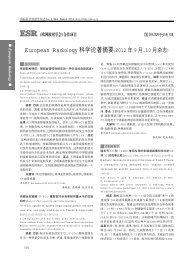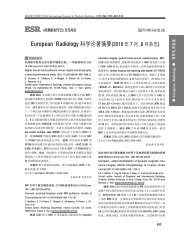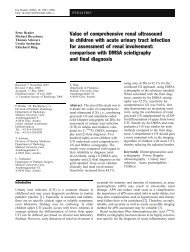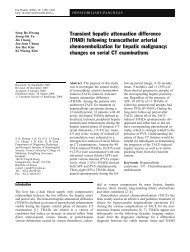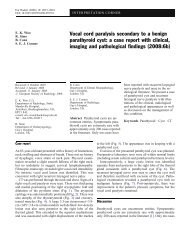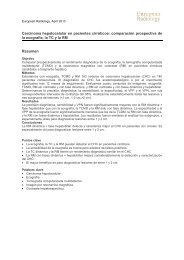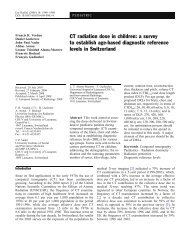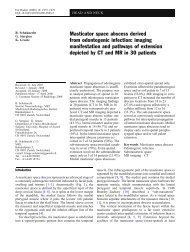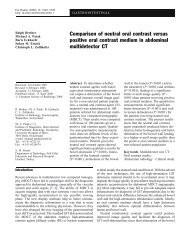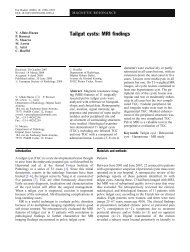View - ResearchGate
View - ResearchGate
View - ResearchGate
Create successful ePaper yourself
Turn your PDF publications into a flip-book with our unique Google optimized e-Paper software.
Eur Radiol (2008) 18: 2739–2744<br />
DOI 10.1007/s00330-008-1061-3 COMPUTER TOMOGRAPHY<br />
Fatih Alper<br />
Metin Akgun<br />
Omer Onbas<br />
Omer Araz<br />
Received: 3 December 2007<br />
Revised: 29 April 2008<br />
Accepted: 2 May 2008<br />
Published online: 26 June 2008<br />
# European Society of Radiology 2008<br />
F. Alper . O. Onbas<br />
Department of Radiology, School of<br />
Medicine, Atatürk University,<br />
Erzurum, Turkey<br />
M. Akgun . O. Araz<br />
Department of Chest Diseases, School<br />
of Medicine, Atatürk University,<br />
Erzurum, Turkey<br />
F. Alper (*)<br />
Atatürk Üniversitesi,<br />
Lojmanları 5. Blok No:2,<br />
Erzurum, Turkey<br />
e-mail: fatihrad@yahoo.com<br />
Tel.: +90-442-3166333<br />
Fax: +90-442-3166340<br />
Introduction<br />
Silicosis is an occupational lung disease caused by<br />
inhalation of crystalline silica dust. Although silicosis is a<br />
well-known disease with very familiar causes such as<br />
tunneling, mining, and sandblasting, and is considered a<br />
preventable condition, it still continues to be reported in<br />
new, unusual, or even unexpected occupations [1–3].<br />
Recently, denim (or jean) sandblasting has been reported as<br />
a new and unusual source of silicosis in Turkey, with a<br />
recent increase in case number, even with fatal outcomes<br />
[4–6].<br />
In denim sandblasting, workers are exposed to silica<br />
because they project silica-containing sand, as an abrasive,<br />
onto denim surfaces to produce a “worn-in” appearance.<br />
This kind of exposure seems to be more hazardous than that<br />
of many previously known sources because of intense<br />
CT findings in silicosis due to denim<br />
sandblasting<br />
Abstract The purpose of this study<br />
was to describe the findings of CT<br />
performed on denim sandblasters with<br />
silicosis. Fifty consecutive male patients<br />
with silicosis were evaluated.<br />
Their clinical data and pulmonary<br />
function tests (PFT) were obtained.<br />
The CT findings were recorded and<br />
the correlations between CT nodular<br />
profusion score and the other<br />
parameters were assessed. The<br />
diagnoses of the patients were classified<br />
as accelerated silicosis (n=43)<br />
and acute silicosis (n=7). The most<br />
common CT finding was centrilobular<br />
nodules. Twenty-three patients had<br />
complicated silicosis based on pleural<br />
involvement and presence of progressive<br />
massive fibrosis (PMF). Lymphadenopathy<br />
(LAP) was positive in<br />
50% of the patients, with calcification<br />
in 24%. The CT grade was highly<br />
correlated with the clinical data such<br />
as exposure duration and PFT. Our<br />
findings suggest that the clinical<br />
manifestation of silicosis in denim<br />
sandblasters is severe. Although the<br />
duration of exposure is shorter the rate<br />
of complicated silicosis patients with<br />
pleural involvement was unexpectedly<br />
higher in the cases. Because the most<br />
common radiological appearance was<br />
nodules and the CT grading of the<br />
nodules was highly correlated with the<br />
clinical data, nodule grading may be<br />
used in the management of such cases.<br />
Keywords CT . Lung . Silicosis .<br />
Occupational diseases .<br />
Denim sandblasting<br />
exposure during long hours of work under very poor<br />
hygiene conditions, without any serious respiratory<br />
protection [4–6].<br />
Although chest radiography remains the most convenient<br />
imaging technique to diagnose silicosis and to<br />
monitor its progression, it has some limitations in<br />
assessment of pneumoconiosis [3]. Thin-section computerized<br />
tomography (CT) has been shown to detect some cases<br />
that are undetectable by chest x-ray and to better<br />
characterize lung involvement [7, 8]. Silicosis associated<br />
with denim sandblasting is a unique issue and has many<br />
different aspects compared with classic silicosis, e.g., it<br />
may develop quickly and may cause immediate mortality,<br />
especially in young people [4–6]. However, no previous<br />
data exist on CT findings of silicosis associated with denim<br />
sandblasting; thus, we aimed to determine the thin-section<br />
CT imaging findings of the cases with silicosis associated
2740<br />
with sandblasting and the correlation between CT findings<br />
and clinical data.<br />
Patients and methods<br />
Patient recruitment and study procedures<br />
This study included 50 consecutive male patients with<br />
clinically proven silicosis who were admitted to a pulmonary<br />
outpatient clinic between August 2004 and June 2007.<br />
Those patients with a smoking history >10 pack-years,<br />
previous tuberculosis history, and active tuberculosis<br />
diseases were excluded from the study. The diagnosis<br />
was based on mainly clinical history, occupational exposure<br />
to silica dust, and chest x-ray findings after other<br />
possible diagnoses were ruled out, except in the first cases<br />
in whom open lung biopsy was required to confirm<br />
diagnosis because no previous association had previously<br />
been described [4].<br />
Demographic and clinical characteristics including<br />
age, exposure duration, smoking history, and spirometry<br />
results, which are forced expiratory volume in one<br />
second (FEV1), forced vital capacity (FVC), and FEV1/<br />
FVC ratio, were recorded. During initial evaluation, all<br />
the patients underwent chest radiography and then thinsection<br />
CT examination. The patients were classified<br />
into three clinical diagnosis categories: classic chronic<br />
silicosis, accelerated silicosis, and acute silicosis/silicoproteinosis<br />
[9].<br />
Written informed consent was obtained from all the<br />
patients, and the study protocol was approved by the<br />
internal review board of the hospital.<br />
Thin-section CT examination<br />
Obtaining CT images<br />
CT was performed with either a Spiral CT (X-Vision,<br />
Tokyo, Japan) (n=47) or 16-detector-row CT system<br />
(Aquillon, Toshiba Medical Systems, Tokyo, Japan) (n=<br />
3). All the CT examinations were obtained at maximal<br />
inspiration in the supine position with 1.5-mm collimation<br />
at 20-mm intervals. The volume of the patient examined<br />
extended from the lung apices to the basis.<br />
The images were photographed with a window level of<br />
−600 HU and a window width of 1,300 HU (i.e., lung<br />
windows) and a window level of 10 HU and a window<br />
width of 300 HU (i.e., mediastinal windows). Additionally,<br />
thin-section CT images were reconstructed with a highspatial-frequency<br />
(bone) algorithm and photographed with<br />
relatively wide window settings to allow evaluation of both<br />
pleura and parenchyma (window center −550 HU, window<br />
width 1,500 HU).<br />
CT evaluation<br />
The CT hard copy images were reviewed independently by<br />
two radiologists who were unaware of the clinical and<br />
radiographic data. Final decision was made by consensus<br />
of the two radiologists.<br />
The reviewers evaluated the images with lung window<br />
for the presence and distribution of nodules, interlobular<br />
septal lines, intralobular septal lines, parenchymal bands,<br />
ground-glass opacity, consolidation, air bronchogram,<br />
progressive massive fibrosis (PMF) or masses, traction<br />
bronchiectasis, honeycombing, lobular low-attenuation<br />
areas, and emphysema. The images were evaluated with<br />
relatively wide window for the presence and severity of<br />
pleural thickening, calcification, and effusion and with<br />
mediastinal window for the presence of lymphadenopathy<br />
with or without calcification. In the presence of calcification,<br />
the type of the calcification (central, eccentric, or eggshell)<br />
was evaluated.<br />
The nodules were characterized with respect to type,<br />
location, and number [10]. Each lung was craniocaudally<br />
divided into upper (apex to carina), middle (carina to<br />
inferior pulmonary vein), and lower (inferior pulmonary<br />
vein to lung base) zones. For qualitative analysis of the<br />
nodules in the craniocaudal axis, the system for grading<br />
nodular profusion on CT involved the use of a modification<br />
of the scale described by Bergin and colleagues. Accordingly,<br />
grade 0 meant no nodules; grade 1, a small number of<br />
nodules without vascular obliteration; grade 2, a larger<br />
number of nodules with mild vascular obliteration; grade 3,<br />
a large number of nodules with moderate vascular<br />
obliteration; and grade 4, a large number of nodules<br />
with severe vascular obliteration, with or without<br />
coalescence (
Fig. 1 CT (lung window)<br />
shows many nodules with mild<br />
vascular obliteration and grade 2<br />
nodular profusion in axial (a)<br />
and coronal (b) plans<br />
PMF, another important finding of silicosis, was defined<br />
as the presence of silicotic nodules larger than 2 cm in<br />
diameter on CT images, according to the criteria used by<br />
the College of American Pathologists [13]. As well as the<br />
presence of PMF, the locations of the PMFs were evaluated<br />
(Fig. 2).<br />
The other parameters (ground-glass opacity, consolidation,<br />
interlobular, intralobular septal thickening, parenchymal<br />
band, traction bronchiectasis, honeycombing, and lobular<br />
low-attenuation area) were defined according to Gotway et al.<br />
[10].<br />
The “crazy-paving” appearance was defined as scattered<br />
or diffuse ground-glass attenuation with superimposed<br />
interlobular septal thickening and intralobular lines. The<br />
“head-cheese sign” was defined as complex CT appearance<br />
of abnormal alveolar infiltrates combined with air trapping.<br />
The presence of pleural thickening and its type (plaquelike<br />
or nodular) were also determined (Fig. 2). In addition,<br />
lymph node enlargement with the short axis exceeding<br />
1 cm was recorded. Lymph node stations were determined<br />
as hilar, subcarinal, pretracheal, and diffuse.<br />
Silicosis was described as two types radiologically:<br />
simple (presence of multiple small nodules 2–5 mmin<br />
Fig. 2 CT (relatively wide window) shows PMF lesion forming<br />
partial distortions more markedly in the apex of the right upper lobe.<br />
Bilateral pleural thickening is also present<br />
diameter) and complicated (also known as PMF, develops<br />
through the expansion and confluence of individual<br />
silicotic nodules) [14].<br />
Finally, whether a correlation existed between the CT<br />
grades and other parameters such as time of exposure,<br />
latency period (time elapsed since beginning of exposure),<br />
age on admission to the hospital, spirometry results,<br />
presence of PMF, and pleural thickening was investigated.<br />
Statistical analyses<br />
The data were analyzed using the SPSS version 11<br />
statistical software (SPSS Inc., Chicago, IL). Correlations<br />
between CT grade and the other parameters were calculated<br />
using Spearman’s rank order correlation coefficients.<br />
Pearson chi-square test was used to compare categorical<br />
values. Mann–Whitney U test was used to compare means<br />
of some variables. P
2742<br />
The most common abnormality found on thin-section<br />
CT was nodules with predominance of centrilobular ones<br />
(n=47, 94%). The radiological classification of the nodules<br />
seen on the CT was as follows: only centrilobular in 30<br />
patients (60%), centrilobular and tree in bud in two (4%),<br />
centrilobular and perilymphatic in 15 (30%), and only<br />
randomized in three (6%).<br />
CT grades in the craniocaudal axis are provided in<br />
Table 1. There was a slight overall increase of nodular<br />
profusion of the upper and middle zones. In contrast to the<br />
predominance of mild disease in the upper zones, there was<br />
lower zone predominance of severe disease. There was<br />
posterior predominance in the anteroposterior axis (Table 2)<br />
and middle and cortical predominance in central-peripheral<br />
axis (Table 3). Sixteen cases had PMF (eight of them were<br />
conglomerate masses; one, calcified mass and one, necrosis).<br />
Presence of PMF increased towards the upper zones in<br />
the craniocaudal distribution (Table 4).<br />
Lymph node enlargement was positive in half of the<br />
cases.. Six cases with lymph node enlargement (12% of all<br />
cases) also had calcification (four eccentric and two<br />
central). No eggshell calcification was determined. In the<br />
evaluation of lymph node stations, there was only hilar<br />
involvement in eight cases, hilar and subcarinal involvement<br />
in four cases, pretracheal in addition to hilar and<br />
subcarinal involvement in one case, and diffuse involvement<br />
in 12 cases. Pleural thickening was positive in 19<br />
cases (38%) and the thickening was plaque-like in 11 cases<br />
and nodular in eight cases. The degree of pleural thickening<br />
was minimal in 12 cases, moderate in four cases, and<br />
diffuse in three cases. Crazy-paving appearance and headcheese<br />
sign were detected in five and three cases,<br />
respectively.<br />
The other findings including axial interstitium thickening,<br />
interlobular septal thickening, intralobular septal<br />
thickening, ground-glass opacification, consolidation, traction<br />
bronchiectasis, pleural effusion, honeycomb, and<br />
lobular low-attenuation areas are summarized Table 5.<br />
Twenty-seven patients had simple silicosis progressing<br />
with nodules only, while the remaining patients had<br />
complicated silicosis (n=23) with PMF (n=16) and/or<br />
pleural pathologies (n=19). No apical scar, bullae, and<br />
paracicatricial emphysema were detected.<br />
All cases were clinically classified as accelerated (n=43)<br />
or acute silicosis/silicoproteinosis (n=7).<br />
Table 2 Anteroposterior distribution of nodules<br />
In the evaluation of an association between radiological<br />
findings and clinical data, there was a positive correlation<br />
between CT grade and exposure duration and age at<br />
admission, and a negative correlation between CT grade<br />
and pulmonary function test parameters (FEV 1 and FVC).<br />
Although the correlation between CT grade and age was<br />
not significant, the correlations between CT grade and<br />
exposure duration (r=0.37, p
Table 3 Central to peripheral axis distribution of nodules<br />
presence of PMF with progression of the disease, and less<br />
lymph node involvement compared with classic silicosis.<br />
Although there are three main clinical presentations of<br />
silicosis, which are classic silicosis, accelerated silicosis,<br />
and acute silicosis/silicoproteinosis, in our study, no classic<br />
chronic silicosis case was detected. Classic chronic silicosis<br />
is the most common presentation, in which patients<br />
remain asymptomatic until after an interval of 10–20 years<br />
of continuous silica exposure, by which time radiographic<br />
evidence is present. In accelerated or acute silicosis, the<br />
exposure time after which the disease becomes clinically<br />
evident is much shorter and the rate of disease progression<br />
noticeably faster. Clinical presentation as early as 1 year<br />
after exposure and death within 5 years has been reported<br />
[15]. The exposure duration and latency period were<br />
shorter in our cases. One of our cases with accelerated<br />
diseases and two with acute diseases died during the study<br />
period. It is highly possible that high concentrations of dust<br />
in a relatively confined space and younger age without<br />
serious protection from severe diseases were responsible as<br />
stated in previous studies [3, 16].<br />
Nearly all patients (94%) had nodules with a predominance<br />
of centrilobular type as seen in classic silicosis [3,<br />
10, 11]. On CT grade evaluation, we detected mid to upper<br />
zone predominance in milder cases (grade I + II) and<br />
middle and lower zone predominance in severe cases<br />
(grade III + IV), which is different from the literature<br />
findings [3]. As opposed to the upper lobe predominance of<br />
classic silicosis, we observed that predominance may be<br />
different according to the severity of disease in these cases.<br />
The evaluation on the axial plane revealed predominance in<br />
the middle and cortical zones of the lungs. Similar to the<br />
literature findings, posterior predominance of the nodules<br />
was also observed [3, 17, 18]. CT grade was significantly<br />
correlated with PMF and nodular pleural thickening.<br />
Although presence of PMF is highly associated with<br />
progressive classic silicosis, we found it in one third of the<br />
cases (32%). In silicosis, PMF usually involves the upper<br />
Table 4 Craniocaudal distribution of PMF<br />
Table 5 Other CT findings<br />
Finding Number Features<br />
2743<br />
Axial interstitium thickening 12 9 smooth<br />
3 nodular<br />
Interlobular septal thickening 7 6 smooth<br />
1 nodular<br />
Intralobular septal thickening 5<br />
Ground glass 6 5 with consolidation<br />
Consolidation 11 5 with air bronchogram<br />
Lobular low-attenuation areas 9<br />
Traction bronchiectasis 4<br />
Honeycomb No<br />
Pleural effusion No<br />
lung zones, and various types of calcification of large<br />
opacities are found, mostly punctate rather than linear or<br />
massive. In our study, it was distributed in all the lung<br />
zones, with a predominance of the upper zone followed by<br />
mid and lower zone involvements, respectively. Although<br />
our findings of PMF locations were compatible with the<br />
literature, mass calcification (1/16) and necrosis (1/16),<br />
which are frequently reported in the literature, were<br />
relatively less common in our study [3, 17]. The relatively<br />
lower incidence of PMF calcifications in our patients might<br />
have been due to the shorter interval of symptom<br />
presentation. Marchiori et al. reported a mean interval of<br />
27.5 years for conglomerated mass development due to<br />
sandblasting, while in our study both exposure duration<br />
and latency period were very short [19]. In our study, a<br />
statistically significant correlation was determined between<br />
the exposure duration and CT grade and PMF presence.<br />
This finding may be important to predetermine the cases<br />
with higher CT grade but no PMF for development of PMF.<br />
In addition, pleural thickening was unexpectedly high in<br />
our study. Arakawa et al. determined a rate of 58% for<br />
pleural thickening in complicated silicosis cases, while this<br />
rate was 69% in our study [13]. Although LAP with<br />
calcification, especially eggshell type, is commonly<br />
encountered in classic cases, half of our cases had LAP<br />
with a low rate of uniform-type calcification and no<br />
eggshell [3]. Another finding of our study was the<br />
statistically significant correlations between CT grade<br />
and both exposure duration and PFT findings. These<br />
findings suggest that radiological findings are highly<br />
correlated with clinical data in such cases.<br />
Although the findings associated with classic silicosis<br />
such as LAP, LAP calcification, and PMF development<br />
were not very prominent, the rate of complicated silicosis<br />
patients with pleural involvement was unexpectedly higher<br />
in the cases with silicosis due to denim sandblasting.<br />
Because the most common radiological appearance was<br />
nodules and the CT grading of the nodules was highly
2744<br />
correlated with the clinical data, nodule grading may be<br />
used in the management of such cases. This radiological<br />
evaluation study also indicates that silicosis is an important<br />
health care problem in the workers of denim sandblasting<br />
References<br />
1. Wagner GR (1997) Asbestosis and<br />
silicosis. Lancet 349:1311–1315<br />
2. Wagner GR (1995) The inexcusable<br />
persistence of silicosis. Am J Public<br />
Health 85:1346–1347<br />
3. Ooi CGC, Arakawa H (2006) Silicosis.<br />
In: Gevenois PA, De Vuyst P (eds)<br />
Imaging of occupational and<br />
environmental disorders of the chest.<br />
Springer-Verlag, Berlin, pp 177–<br />
193<br />
4. Akgun M, Gorguner M, Meral M,<br />
Turkyilmaz A, Erdogan F, Saglam L,<br />
Mirici A (2005) Silicosis caused by<br />
sandblasting of jeans in Turkey: a<br />
report of two concomitant cases. J<br />
Occup Health 47:346–349<br />
5. Akgun M, Mirici A, Ucar EY, Kantarci<br />
M, Araz O, Gorguner M (2006)<br />
Silicosis in Turkish denim sandblasters.<br />
Occup Med 56:554–558<br />
6. Cimrin A, Sigsgaard T, Nemery B<br />
(2006) Sandblasting jeans kills young<br />
people. Eur Respir J 28:885–886<br />
7. Begin R, Ostiguy G, Fillion R, Colman<br />
N (1991) Computed tomography in the<br />
early detection of silicosis. Am Rev<br />
Respir Dis 144:697–705<br />
8. Gevenois PA, Pichot E, Dargent F,<br />
Dedeire S, Vande Weyer R, De Vuyst P<br />
(1994) Low grade coal worker’s<br />
pneumoconiosis. Comparison of CT<br />
and chest radiography. Acta Radiol<br />
35:351–356<br />
9. Churg A (2006) Pathological reactions<br />
to inhaled particles and fibers. In:<br />
Gevenois PA, De Vuyst P (eds)<br />
Imaging of occupational and<br />
environmental disorders of the chest.<br />
Springer-Verlag, Berlin, pp 13–30<br />
10. Gotway MB, Reddy GP, Webb WR,<br />
Elicker BM, Leung JW (2005) Highresolution<br />
CT of the lung: patterns of<br />
disease and differential diagnoses.<br />
Radiol Clin North Am 43:513–542<br />
11. Bergin CJ, Müller NL, Vedal S,<br />
Chan-Yeung M (1986) CT in silicosis:<br />
correlation with plain films and<br />
pulmonary function tests. AJR<br />
146:477–483<br />
12. Ooi GC, Tsang KW, Cheung TF,<br />
Khong PL, Ho IW, Ip MS, Tam CM,<br />
Ngan H, Lam WK, Chan FL, Chan-<br />
Yeung M (2003) Silicosis in 76 men:<br />
qualitative and quantitative CT evaluation–clinical-radiologic<br />
correlation<br />
study. Radiology 228:816–825<br />
although they had a very short exposure duration. Therefore<br />
to prevent the disease development in this sector<br />
appropriate measures should be initiated as soon as<br />
possible.<br />
13. Arakawa H, Honma K, Saito Y, Shida<br />
H, Morikubo H, Suganuma N, Fujioka<br />
M (2005) Pleural disease in silicosis:<br />
pleural thickening, effusion, and invagination.<br />
Radiology 236:685–693<br />
14. Chong S, Lee KS, Chung MJ, Han J,<br />
Kwon OJ, Kim TS (2006) Pneumoconiosis:<br />
comparison of imaging and<br />
pathologic findings. Radiographics<br />
26:59–77<br />
15. Jiang CQ, Xiao LW, Lam TH, Xie NW,<br />
Zhu CQ (2001) Accelerated silicosis in<br />
workers exposed to agate dust in<br />
Guangzhou, China. Am J Ind Med 40<br />
(1):87–91<br />
16. Michel RD, Morris JF (1964) Acute<br />
silicosis. Arch Intern Med 113:850–855<br />
17. Akira M (2002) High-resolution CT in<br />
the evaluation of occupational and<br />
environmental disease. Radiol Clin<br />
North Am 40:43–59<br />
18. Kim KI, Kim CW, Lee MK, Lee KS,<br />
Park CK, Choi SJ, Kim JG (2001)<br />
Imaging of occupational lung disease.<br />
Radiographics 21:1371–1391<br />
19. Marchiori E, Ferreira A, Saez F,<br />
Gabetto JM, Souza AS Jr, Escuissato<br />
DL, Gasparetto EL (2006) Conglomerated<br />
masses of silicosis in sandblasters:<br />
high-resolution CT findings. Eur J<br />
Radiol 59:56–59



